Conference Presentations by Gudrun De Boeck
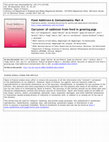
Growing male pigs were exposed to cadmium (Cd) at levels around 1 and 10 mg kg -1 feed for up to ... more Growing male pigs were exposed to cadmium (Cd) at levels around 1 and 10 mg kg -1 feed for up to 12 weeks, administered as CdCl 2 or Cd-cysteine (CdCys). Pigs exposed to 10 mg kg -1 showed decreased growth during the last 3 weeks. Liver and kidney concentrations of Cd continuously increased over the entire 12-week exposure, exceeding the European Union limits of 1.0 mg kg -1 (kidney) and 0.5 mg kg -1 (liver) within 3 weeks at the feed level of 10 mg kg -1 . A switch to clean feed after 3 weeks for 5 or 9 weeks resulted in steadily decreased levels in kidney and liver, which could be completely attributed to organ growth. At the lower feed level, the level in kidney exceeded the limit almost twofold after 12 weeks, but not after 3 weeks. Liver levels remained below the limit. Metallothionein (MT) levels in livers showed a steady decrease in both untreated and treated animals over time. In kidney such a decrease was only observed in control animals, whereas in the highest-dosed animals the MT concentrations steadily increased. The observed carryover of Cd from feed to liver and kidney was modelled by means of a simple transfer model relating levels in feed via MT levels to accumulation of Cd. Using this model, it was shown that the exposure period of growing pigs to feed containing the European Union limit of 0.5 mg kg -1 feed should be less than 12 weeks in order to prevent Cd levels in the kidneys to exceed the European Union limit.
Metal pollution in estuaries and bays around Vitória island (SE Brazil) was monitored • (Heavy) M... more Metal pollution in estuaries and bays around Vitória island (SE Brazil) was monitored • (Heavy) Metal load in water, suspended matter and sediment were determined • Biological parameters and bioaccumulation of metals measured in three mussels species • Contamination for Cd, Cu, Fe and Mn was higher in mussels at low salinity sites • Energy store and condition index in mussels correlated with salinity gradient a b s t r a c t
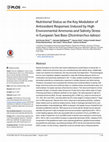
Salinity fluctuation is one of the main factors affecting the overall fitness of marine fish. In ... more Salinity fluctuation is one of the main factors affecting the overall fitness of marine fish. In addition, water borne ammonia may occur simultaneously with salinity stress. Additionally, under such stressful circumstances, fish may encounter food deprivation. The physiological and ion-osmo regulatory adaptive capacities to cope with all these stressors alone or in combination are extensively addressed in fish. To date, studies revealing the modulation of antioxidant potential as compensatory response to multiple stressors are rather lacking. Therefore, the present work evaluated the individual and combined effects of salinity challenge, ammonia toxicity and nutritional status on oxidative stress and antioxidant status in a marine teleost, European sea bass (Dicentrarchus labrax). Fish were acclimated to normal seawater (32 ppt), to brackish water (20 ppt and 10 ppt) and to hypo-saline water (2.5 ppt). Following acclimation to different salinities for two weeks, fish were exposed to high environmental ammonia (HEA, 20 mg/L representing 50% of 96h LC 50 value for ammonia) for 12 h, 48 h, 84 h and 180 h, and were either fed (2% body weight) or fasted (unfed for 7 days prior to HEA exposure). Results show that in response to decreasing salinities, oxidative stress indices such as xanthine oxidase activity, levels of hydrogen peroxide (H 2 O 2 ) and lipid peroxidation (malondialdehyde, MDA) increased in the hepatic tissue of fasted fish but remained unaffected in fed fish. HEA exposure at normal salinity (32 ppt) and at reduced salinities (20 ppt and 10 ppt) increased ammonia accumulation significantly (84 h-180 h) in both feeding regimes which was associated with an increment of H 2 O 2 and MDA contents. Unlike in fasted fish, H 2 O 2 and MDA levels in fed fish were restored to control levels (84 h-180 h); with a concomitant increase in superoxide dismutase (SOD), catalase (CAT), components of the glutathione redox cycle (reduced glutathione, glutathione peroxidase and glutathione reductase), ascorbate peroxidase (APX) activity and reduced ascorbate (ASC) content. On the contrary, fasted fish could not activate many of these protective PLOS ONE | systems and rely mainly on CAT and ASC dependent pathways as antioxidative sentinels. The present findings exemplify that in fed fish single factors and a combination of HEA exposure and reduced seawater salinities (upto 10 ppt) were insufficient to cause oxidative damage due to the highly competent antioxidant system compared to fasted fish. However, the impact of HEA exposure at a hypo-saline environment (2.5 ppt) also defied antioxidant defence system in fed fish, suggesting this combined factor is beyond the tolerance range for both feeding groups. Overall, our results indicate that the oxidative stress mediated by the experimental conditions were exacerbated during starvation, and also suggest that feed deprivation particularly at reduced seawater salinities can instigate fish more susceptible to ammonia toxicity. Antioxidant Defences in Fish to Multiple-Stressors PLOS ONE |

The main objective of this study was to understand the mode of interaction between waterborne cop... more The main objective of this study was to understand the mode of interaction between waterborne copper (Cu) and high environmental ammonia (HEA) exposure on freshwater fish, and how they influence the toxicity of each other when present together. For this purpose, individual and combined effects of Cu and HEA were examined on selected physiological and ion-regulatory processes and changes at transcript level in the common carp (Cyprinus carpio). Juvenile carp were exposed to 2.6 M Cu (25% of the 96 h LC 50 value) and to 0.65 mM ammonia (25% of the 96 h LC 50 value) singly and as a mixture for 12 h, 24 h, 48 h, 84 h and 180 h. Responses such as ammonia (J amm ) and urea (J urea ) excretion rate, plasma ammonia and urea, plasma ions (Na + , Cl − and K + ), muscle water content (MWC) as well as branchial Na + /K + -ATPase (NKA) and H + -ATPase activity, and branchial mRNA expression of NKA, H + -ATPase, Na + /H + exchanger (NHE-3) and Rhesus (Rh) glycoproteins were investigated under experimental conditions. Results show that J amm was inhibited during Cu exposure, while HEA exposed fish were able to increase excretion efficiently. In the combined exposure, J amm remained at the control levels indicating that Cu and HEA abolished each other's effect. Expression of Rhcg (Rhcg-a and Rhcg-b) mRNA was upregulated during HEA, thereby facilitated ammonia efflux out of gills. On the contrary, Rhcg-a transcript level declined following Cu exposure which might account for Cu induced J amm inhibition. Likewise, Rhcg-a was also down-regulated in Cu-HEA co-exposed fish whilst a temporary increment was noted for Rhch-b. Fish exposed to HEA displayed pronounced up-regulation in NKA expression and activity and stable plasma ion levels. In both the Cu exposure alone and combined Cu-HEA exposure, ion-osmo homeostasis was adversely affected, exemplified by the significant reduction in plasma [Na + ] and [Cl − ], and elevated plasma [K + ], along with an elevation in MWC. These changes were accompanied by a decline in NKA activity. Gill H + -ATPase mRNA levels and activities were not affected by either Cu or HEA or both. Likewise, NHE-3 expression remained unaltered but tended to be numerically higher during HEA exposure. Overall, these data suggest that at equitoxic concentrations (25% of 96 h LC 50 ), the individual effect of Cu is more harmful while HEA induces quicker adaptive responses. Our findings also denote a competitive mode of interaction, exemplified by the inhibition of HEA -mediated adaptive responses in the presence of Cu.
In the present study, the effect of copper was examined in the common goldfish (Carassius auratus... more In the present study, the effect of copper was examined in the common goldfish (Carassius auratus auratus). Fish were fasted and exposed to either a high (0.84 μM), a low (0.34 μM) or a control copper concentration (0.05 μM) for 1 and 7 days. Swimming performance was not affected by either fasting or copper exposure. Food deprivation alone had no effect on ionoregulation, but low plasma osmolality levels and plasma Na + were noticed in fasted fish exposed to Cu for 7 days. Both gill Na + /K + -ATPase and H + -ATPase activities were undisturbed, while both kidney ATPase activities were up-regulated when challenged with the high Cu levels. Up-regulated kidney ATPase activities likely acted as compensatory strategy to enhance Na + reabsorption. However, this up-regulation was not sufficient to restore Na + to control levels in the highest exposure group.
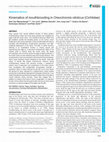
Many species from several different families of fishes perform mouthbrooding, where one of the se... more Many species from several different families of fishes perform mouthbrooding, where one of the sexes protects and ventilates the eggs inside the mouth cavity. This ventilation behaviour differs from gill ventilation outside the brooding period, as the normal, smallamplitude suction-pump respiration cycles are alternated with actions including near-simultaneous closed-mouth protrusions and highamplitude depressions of the hyoid. The latter is called churning, referring to its hypothetical function in moving around and repositioning the eggs by a presumed hydrodynamic effect of the marked shifts in volume along the mouth cavity. We tested the hypothesis that churning causes the eggs located posteriorly in the mouth cavity to move anteriorly away from the gill entrance. This would prevent or clear accumulations of brood at the branchial basket, which would otherwise hinder breathing by the parent. Dual-view videos of female Nile tilapias (Oreochromis niloticus) during mouthbrooding showed that churning involves a posterior-toanterior wave of expansion and compression of the head volume. Flow visualisation with polyethylene microspheres revealed a significant inflow of water entering the gill slits at the zone above the pectoral fin base, followed by a predominantly ventral outflow passing the ventrolaterally flapping branchiostegal membranes. X-ray videos indicated that particularly the brood located close to the gills is moved anteriorly during churning. These data suggest that, in addition to mixing of the brood to aid its oxygenation, an important function of the anterior flow through the gills and buccal cavity during churning is to prevent clogging of the eggs near the gills.
Nothobranchius furzeri is a promising model for ecotoxicological research due to the species' sho... more Nothobranchius furzeri is a promising model for ecotoxicological research due to the species' short life cycle and the production of drought-resistant eggs. Although the species is an emerging vertebrate fish model for several fundamental as well as applied research domains, its potential for ecotoxicological research has not yet been tested.
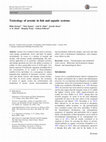
Arsenic (As) is found in waters such as seawater, warm springs, groundwater, rivers, and lakes. I... more Arsenic (As) is found in waters such as seawater, warm springs, groundwater, rivers, and lakes. In aquatic environments, As occurs as a mixture of arsenate and arsenite, with arsenate usually predominating. The unrestricted application of As pesticides, industrial activities, and mining operations has led to the global occurrence of soluble As above permissible levels of 0.010 mg/L. Continuous exposure of freshwater organisms including fish to low concentrations of As results in bioaccumulation, notably in liver and kidney. As a consequence As induces hyperglycemia, depletion of enzymatic activities, various acute and chronic toxicity, and immune system dysfunction. Here we review arsenic chemistry, the occurrence of arsenic in aquatic system, the transformation and metabolism of arsenic; arsenic bioaccumulation and bioconcentration; behavioral changes; and acute and other effects such as biochemical, immunotoxic, and cytogenotoxic effects on fish.

_ Serotonin (5_hydroxytryptamine, 5-HT) and dopamine (DA) are two major monoamine neurotransmitte... more _ Serotonin (5_hydroxytryptamine, 5-HT) and dopamine (DA) are two major monoamine neurotransmitters with a multitude of functions in the vertebrate brain. In fish, the 5-HT system has been shown to be sensitive to various forms of stress, but very few studies have examined the effects of toxic metals on these monoamine systems. Juvenile common carp were exposed to copper levels of 0.22, 0.34 and 0.84 ,uM during 1 week. In telencephalon, dose-dependent falls in 5-HT and DA levels were observed, with approximately 50% losses of these neurotransmitters at the highest copper concentration. Although less dramatic, falls were also seen in 5-HT and DA levels in hypothalamus and brain stem. No changes in 5-hydroxyindoleacetic acid (5-HIAA, the main 5-HT metabolite), AMP, ADP, ATP, adenylate energy charge or lactate levels were observed in brain. However, lactate levels in blood plasma increased with copper concentration. A significant copper accumulation only occurred in the liver, while no changes in brain or muscle were seen. It is concluded that copper exposure of common carp causes decreased brain 5-HT and DA levels, two neurotransmitters involved in, for example, feeding behaviour and locomotor control in fish. In fact, in telencephalon a fall in 5-HT levels was seen already at a copper concentration below that where food intake and movement were impaired.

Contamination by heavy metals in aquatic environments is a serious concern due to increasing huma... more Contamination by heavy metals in aquatic environments is a serious concern due to increasing human activities over the last decades. Moreover, productive areas such as estuaries have even been more affected because of the complex interaction between fluvial and marine processes, creating a stressful environment with gradients of salinity and other important parameters which can intensify negative effects of pollutants on biota such as euryhaline fish. (Oliva et al., 2012; Mieiro et al 2012). European sea bass (Dicentrarchus labrax l.) is a euryhaline species able to withstand a large variation in salinity and is considered as a bioindicador due to both economic and ecological importance (Joseph., et al 2011; Loizeau, 2001). Copper as essential micronutrient has important roles in cellular, enzymatical and protein mechanisms but is potentially toxic when its concentration increases above a certain threshold (Blanchard & Grosell, 2005; Grosell et al., 2007), and can even be more toxic than cadmium, a non-essential metal (Roméo et al., 2000) which is ubiquitous in environment and one of the most deleterious heavy metal pollutants (Nath et al., 1984 cited by Loaiza, 2011). Therefore, the effect of salinity on the acute toxicity of copper and cadmium in European sea bass D. labrax l. was examined to determine 96h-LC50 values (the lethal concentration where 50% of the population dies) at different exposure concentration of both metals (at 0 to 5100 μgCu L-1 and at 0 to 20000 μgCd L-1) over a broad salinity range (1, 2.5, 5, 10, 20, 28, 35‰) in juvenile sea bass during a period of 10 days. The results showed an important influence of the salinity in the toxicity in both elements, where for Cu mortality first decreased with increasing salinity but increased again at higher salinities and for Cd, mortality decreased continuously with increasing salinity, to a point where no reliable LC50 could be determined at the 2 highest salinities. In addition, it was observed that the individuals were affected in different ways. For instance Cu exposed fish at low salinity showed opened gills at die-off. Copper is readily taken up by the gill, where it inhibits the action of Na+/K+ adenosine triphosphatase, resulting in an osmoregulatory disturbance as Na+ is lost to the dilute external environment (Blanchard et al. 2006). In conclusion, the salinity influences the toxicity differently for Cu and Cd. This not only occurs due to the fact that salinity plays an important role in the speciation of pollutants and competition by cations in uptake processes, but as can be clearly seen in the case of Cu, also by the physiology of the fish that responds to the changes in the environment. Further research on the relationship between bio-accumulation of the metals and the mortality at different salinities is planned.
Papers by Gudrun De Boeck
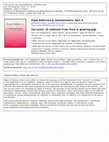
Http Dx Doi Org 10 1080 19440049 2014 979370, Dec 23, 2014
Growing male pigs were exposed to cadmium (Cd) at levels around 1 and 10 mg kg -1 feed for up to ... more Growing male pigs were exposed to cadmium (Cd) at levels around 1 and 10 mg kg -1 feed for up to 12 weeks, administered as CdCl 2 or Cd-cysteine (CdCys). Pigs exposed to 10 mg kg -1 showed decreased growth during the last 3 weeks. Liver and kidney concentrations of Cd continuously increased over the entire 12-week exposure, exceeding the European Union limits of 1.0 mg kg -1 (kidney) and 0.5 mg kg -1 (liver) within 3 weeks at the feed level of 10 mg kg -1 . A switch to clean feed after 3 weeks for 5 or 9 weeks resulted in steadily decreased levels in kidney and liver, which could be completely attributed to organ growth. At the lower feed level, the level in kidney exceeded the limit almost twofold after 12 weeks, but not after 3 weeks. Liver levels remained below the limit. Metallothionein (MT) levels in livers showed a steady decrease in both untreated and treated animals over time. In kidney such a decrease was only observed in control animals, whereas in the highest-dosed animals the MT concentrations steadily increased. The observed carryover of Cd from feed to liver and kidney was modelled by means of a simple transfer model relating levels in feed via MT levels to accumulation of Cd. Using this model, it was shown that the exposure period of growing pigs to feed containing the European Union limit of 0.5 mg kg -1 feed should be less than 12 weeks in order to prevent Cd levels in the kidneys to exceed the European Union limit.
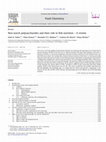
The success and sustainability of aquaculture depends on minimising the operational cost of feed ... more The success and sustainability of aquaculture depends on minimising the operational cost of feed that in general comprises 50-60% of the total cost in intensive farming. The major feed ingredient, fish meal, is expensive and there is increasing competition with other livestock industries for the available static supply of fish meal. Hence, the incorporation of plant-derived materials in fish feeds is receiving increasing attention. One of the main constraints in the utilisation of plant ingredients in aquaculture is the presence of indigestible carbohydrates, which consist primarily of non-starch polysaccharides (NSPs). These form a part of the cell wall structure of cereals and legumes. The presence of NSPs in the diet interferes with feed utilisation and adversely affects performance of the animal. Supplementation of NSP-degrading enzymes in feed mitigates the adverse effects of NSPs. The effects of NSPs in pigs and poultry have been widely studied; however little information exists for fish. This review synthesizes the available information on fish and highlights the knowledge gaps. It is hoped that this review will provide a momentum to the research on the roles of NSPs in fish nutrition and physiology and on the efficient use of NSP-degrading enzymes.

The Journal of experimental biology, Jan 15, 2016
Many species from several different families of fishes perform mouthbrooding, where one of the se... more Many species from several different families of fishes perform mouthbrooding, where one of the sexes protects and ventilates the eggs inside the mouth cavity. This ventilation behaviour differs from gill ventilation outside the brooding period, as the normal, small-amplitude suction-pump respiration cycles are alternated with actions including near-simultaneous closed-mouth protrusions and high-amplitude depressions of the hyoid. The latter is called churning, referring to its hypothetical function in moving around and repositioning the eggs by a presumed hydrodynamic effect of the marked shifts in volume along the mouth cavity. We tested the hypothesis that churning causes the eggs located posteriorly in the mouth cavity to move anteriorly away from the gill entrance. This would prevent or clear accumulations of brood at the branchial basket, which would otherwise hinder breathing by the parent. Dual-view videos of female Nile tilapias (Oreochromis niloticus) during mouthbrooding s...
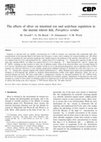
Comp Biochem Physiol C Pharmacol Toxicol Endocrinol, 1999
Exposure to elevated silver (as AgNO 3 ) concentrations (6 -9 mM) in seawater was associated with... more Exposure to elevated silver (as AgNO 3 ) concentrations (6 -9 mM) in seawater was associated with comparably high silver concentrations in the intestinal fluids of the lemon sole (Parophrys 6etulus), and a tendency for reduced drinking rate. The effects of silver on intestinal ion and acid-base regulation were studied using in situ perfusion of the intestine. Intestinal net Cl − uptake was reduced from 0.4 to 0.1 and intestinal net Na + uptake from 0.2 to 0 mmol kg − 1 h − 1 during silver exposure (9 mM). At the same time, intestinal HCO 3 − net efflux was reduced from 0.2 to 0.1 mmol kg − 1 h − 1 . Both intestinal Na + and Cl − uptake and Cl − /HCO 3 − exchange are thus sensitive to silver, but to different extents. None of the observed effects were reversible during 24 h of recovery. Intestinal water transport was highly variable in vivo in the perfused preparation, and no significant effect of silver exposure was observed. However, in vitro intestine preparations exhibited reduction of intestinal net water flux from 4 to 1 ml cm − 2 h − 1 during silver exposure together with reduced unidirectional Cl − influx. Reduced water intake and transepithelial water transport in silver-exposed fish resulted in moderate hemoconcentration evident from higher hematocrit values, but not in increased plasma ion levels. The latter could reflect a compensatory response via increased branchial Na + /K + -ATPase levels, observed in silver-exposed fish, indicative of increased branchial ion transport capacity. Impairment of intestinal ion and water transport as a result of silver intake via drinking could be an important part of the fatal cascade of physiological effects observed in marine fish during acute silver exposure.

Uploads
Conference Presentations by Gudrun De Boeck
Papers by Gudrun De Boeck